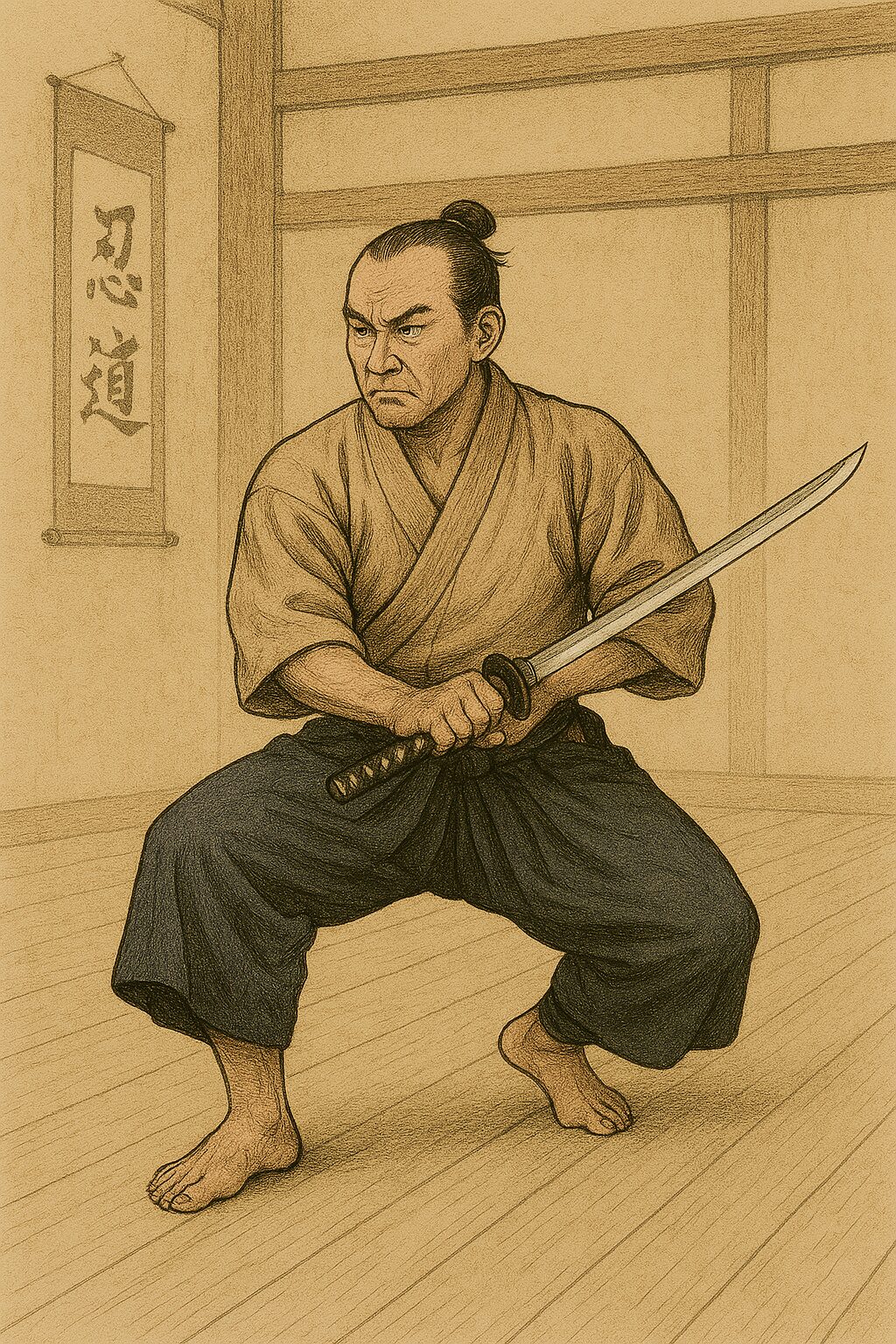✨ Introduction: Where Myth Meets Mastery
When people in the West hear “martial arts,” they often picture high-flying kicks, cinematic duels, or competitive sports like karate or MMA. But Japan’s ancient martial traditions—koryū bujutsu—are something far deeper. They are spiritual disciplines, cultural legacies, and living philosophies that trace their roots not just to history, but to myth.
One of the most powerful stories comes from Japan’s oldest chronicles, the Kojiki and Nihon Shoki. In these texts, a divine warrior named Takemikazuchi-no-Kami is sent from the heavens to negotiate the peaceful transfer of the earthly realm from the great deity Ōkuninushi. But he doesn’t come with an army. He comes with a sword.
According to the Kojiki, Takemikazuchi draws his long blade, thrusts it upside-down into the waves, and sits cross-legged atop its tip. In the Nihon Shoki, the sword is planted in the earth. In both versions, the message is clear: this is not a threat of violence, but a demonstration of unshakable presence, balance, and spiritual authority.
This act—sitting calmly on the tip of a blade—is not meant to be taken literally. Even in ancient times, people would have known such a feat was impossible. Instead, it is a metaphor. A symbol of a warrior so composed, so centered, that even the sharpest danger cannot disturb him. It is the essence of Japanese martial arts: to overcome not through force, but through presence.
🧬 The Lineage of the Sword Gods
Takemikazuchi is not alone. He is accompanied by another divine warrior, Futsunushi-no-Kami. Both are descended from gods born of fire and blood—deities associated with blades, destruction, and purification. Their names appear in the genealogies of the Kojiki and Nihon Shoki, and they are enshrined at Kashima Shrine and Katori Shrine, respectively.
These two shrines, facing each other across the Tone River, are the spiritual homes of Japan’s oldest martial arts traditions: Kashima Shintō-ryū and Katori Shintō-ryū. These are not merely schools of combat—they are sacred lineages, passed down for over two thousand years. Katori Shintō-ryū, in particular, is considered the oldest surviving martial arts school in Japan.
🥋 Martial Arts as a Path, Not a Sport
Unlike modern sports, these ancient martial arts were not about competition or spectacle. They were about survival, discipline, and spiritual refinement. In a world where brute strength often prevailed, Japanese martial arts developed as a way for the small to overcome the strong, the few to overcome the many—through technique, timing, and inner calm.
Over centuries, these arts were refined by generations of masters. Techniques were passed down, tested, and improved. Warriors traveled across the country on musha shugyō—pilgrimages of training and challenge—to learn from other schools and sharpen their skills. What emerged was not just a system of combat, but a philosophy of life.
⚔️ The Duel of the Gods: Technique Over Strength
The myth continues with a duel between Takemikazuchi and Ōkuninushi’s son, Takeminakata-no-Kami. Takeminakata is described as immensely strong—able to lift a boulder that would take a thousand men to move. He challenges Takemikazuchi to a test of strength.
But when he grabs Takemikazuchi’s arm, it transforms into a frozen blade. Shocked, he retreats. Then Takemikazuchi grabs his arm—and throws him like a bundle of reeds. Takeminakata flees, only to be pursued and subdued in distant Suwa.
This story is more than myth. It reflects the core of Japanese martial arts: that true power lies not in brute strength, but in refined technique and spiritual presence. The ancient term for this kind of contest was tegōi—a precursor to sumo, but also a window into the subtle, devastating techniques of classical martial arts.
🧍 A Personal Encounter with the Impossible
I once visited a master of an ancient martial tradition. He handed me a live blade and told me to strike him. Alarmed, I asked to use a wooden sword instead. He agreed—but insisted I strike with full force.
He wore no armor. He held no weapon. As I stepped forward and raised my sword, he simply lowered his stance and extended his hand toward my throat.
In that instant, I froze. My sword stopped mid-air. I could not move. I was paralyzed—not by fear, but by something deeper. He calmly took the sword from my hands. I remained frozen, like a statue.
What had happened? I still don’t fully understand. Perhaps, as the ancients believed, he had drawn out my hi—my spirit. Without it, my body could not act. This was not sport. This was something else entirely.
🕊️ A Hypothesis from the Jōmon Era
Japan’s Jōmon period lasted over 14,000 years. Archaeologists have found no evidence of warfare or mass violence from that time. Could it be that martial arts—refined, non-lethal, and spiritual—played a role in maintaining peace?
Perhaps the ability to subdue without harm, to control without killing, was so advanced that weapons like swords were unnecessary. Indeed, while bows and spears appear in Jōmon sites, swords do not. In close combat, perhaps the body itself—trained and spiritually honed—was the ultimate weapon.
📜 From Myth to Modernity
The spirit of these ancient arts lives on. Schools like Daitō-ryū and Aikidō trace their roots to legendary figures like Shinra Saburō Yoshimitsu. Even in the modern era, martial arts were part of diplomatic missions. Envoys like Ono no Imoko, sent to China in the 7th century, were chosen not only for intellect and appearance—but for martial prowess.
Today, Japanese martial arts continue to evolve. But at their core, they remain what they have always been: a path of self-mastery, rooted in myth, refined through centuries, and alive in every movement of the true practitioner.



コメント